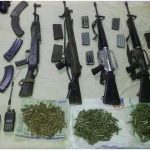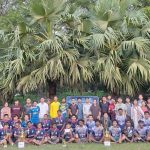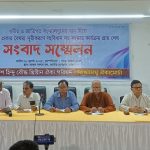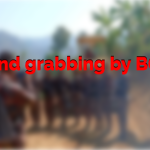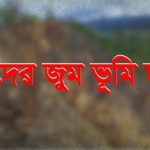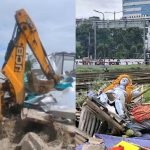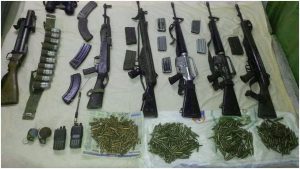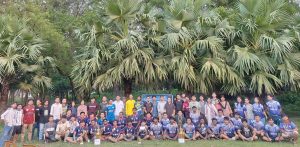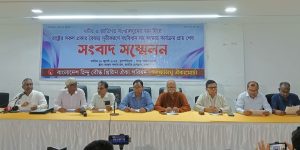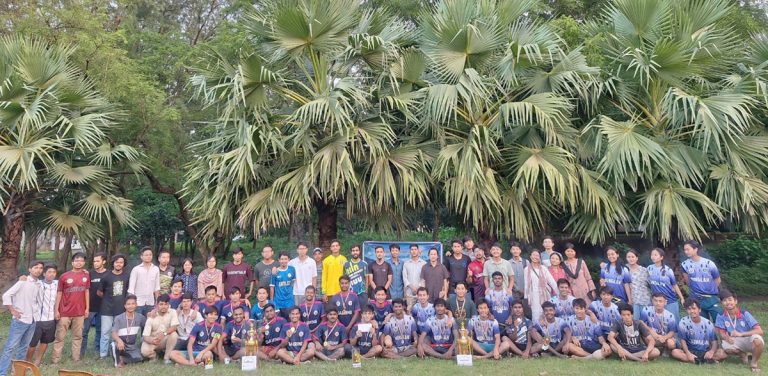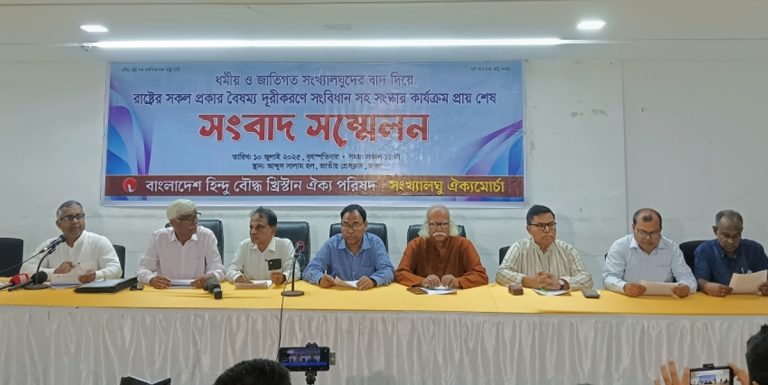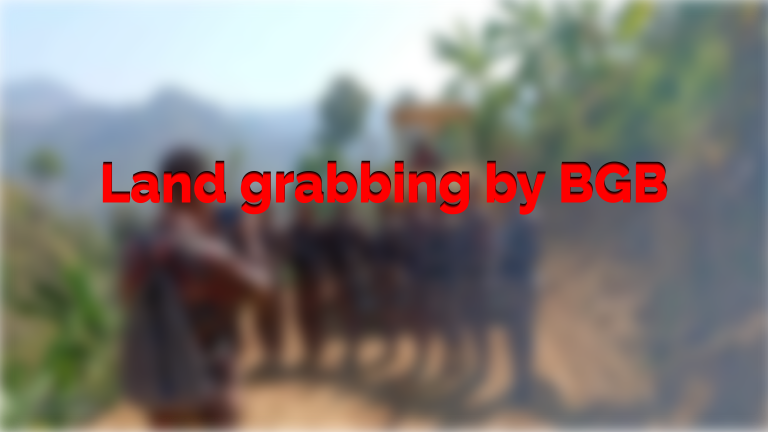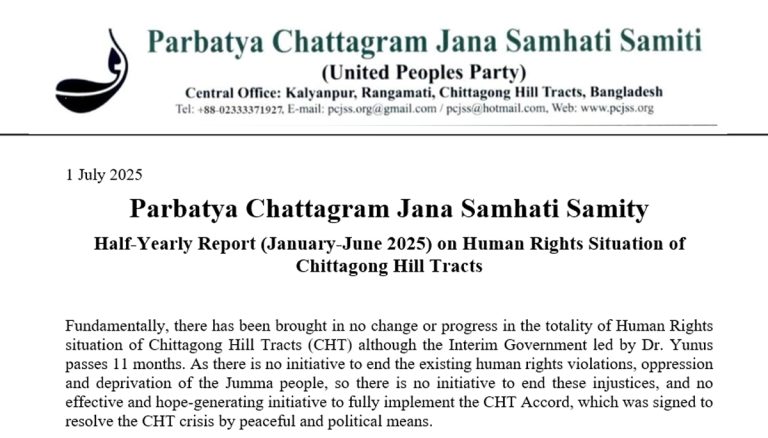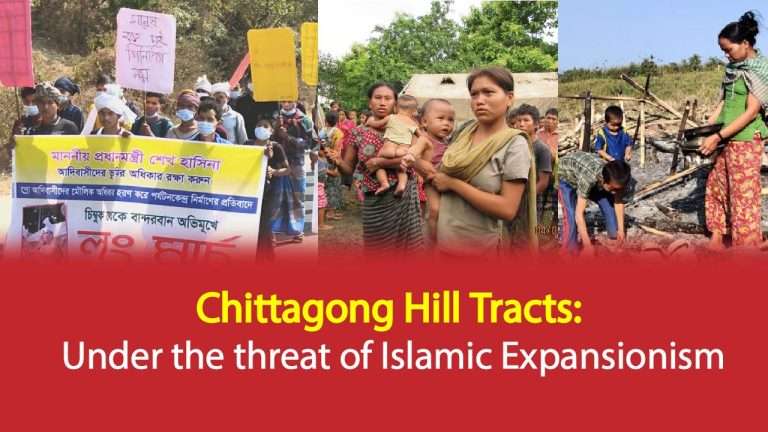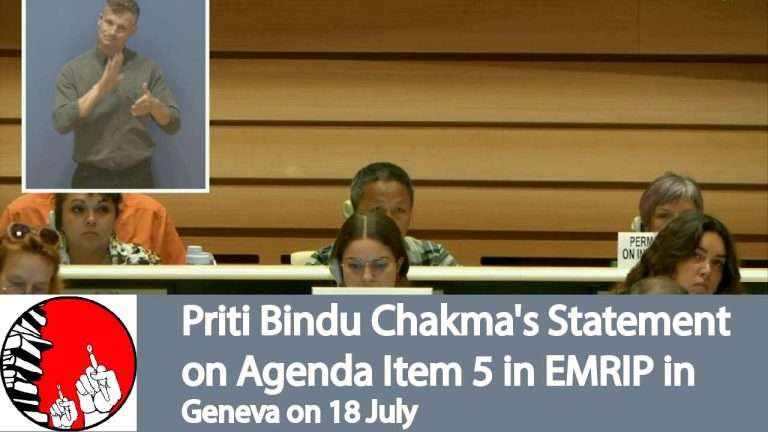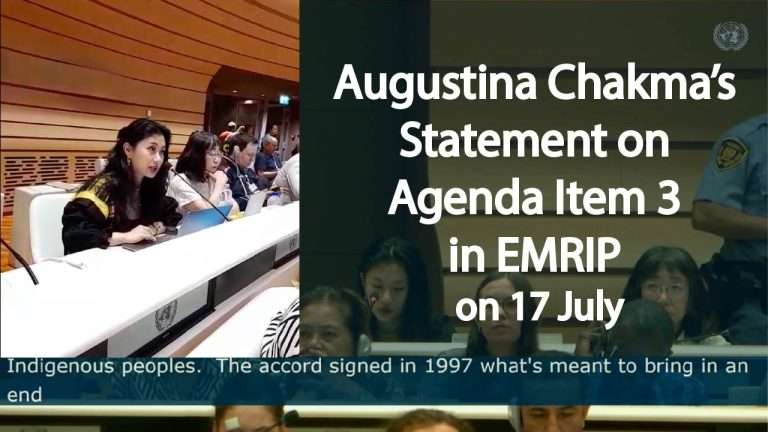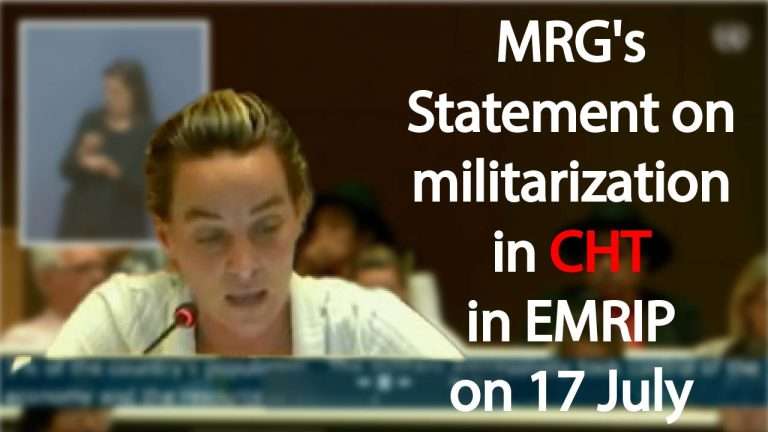Chinglamong Chak
In Chittagong Hill Tracts (CHT) the indigenous Mro people who are the most backward in all respects constitute one of the vulnerable victims to the forcible occupation of lands being carried out by the influential individuals, institutions and companies under indulgence of the local administration. Various researches and surveys reveal that at least 22,300 acres of their lands have been occupied without their consent as of this day and at least 1,100 families of 30 villages have been evicted from their respective homesteads and lands. Right now, more than 12,895 acres of lands are in the pipe line of forcible occupation for which some 1,165 families of 71 villages are staying under threat of eviction.
Meanwhile, hundreds of thousands acres of ancestral lands of the Mro people have been forcibly occupied in the areas of Chimbuk, Sualok and Tonkaboti Unions under Bandarban Sadar; Soroi, Fashyakhali and Ruposhi Union of Lama Upazila and the lands lying both sides of Alikadam-Thanchi Road on the Krawdaung hills by way of giving in leases in the name of rubber plantations to the outsiders, influential figures, institutions, companies and allotting on requisition to the army for military training. The lands with rubber plantations that catch eyes right from the entrance point and onward stretching either side of the Chittagong-Chakoria-Lama main Road, mostly have been traditional jum (shifting) cultivation lands and dwelling lands of the Mro people. Due to indiscriminating and illegal occupation of lands and forcible eviction, their dwelling and arable lands have got shrunk. Holistically, the negative impact has overshadowed their lives and livelihood. The hill slopes that constitute the lands for Jum cultivation, sole means for their lives and livelihood have got reduced to barest minimum.
It is notable that Bandarban Hill District is the only locality wherein the Mro people dwell among the three hill district in CHT. Before construction of the Kaptai Dam in 1960, in Bharjyatoli Mouza of Kaptai Upazila of Rangamati hill district, there was a settlement of some Mro families. Due to the dam, they were evicted and they voluntarily shifted to Bandarban hill district. According to Census-2011, the Mro population in Bandarban was 38,021. But according to the statement of Mro Social Council, the Mro population is more than that of the census. The survey conducted by Mro Social Council in 1995, the population Mro people is 59,748.
Though the Mro people constitute to be the second largest indigenous ethnic group in Bandarban hill district yet they are very backward in education and other aspects. It is only the Jum cultivation that they practice as the only livelihood. The lands for plough cultivation or agriculture is almost nil under their possession. Their localities are centered on the Chimbuk hill near Bandarban district town. Tonkaboti Union is one of their chief dwelling localities. In Tonkaboti, there are only two villages of different ethnic community peoples among the majority Mros. Due to conspiracy of certain quarters and influential land robbers, the Mros, for having been uprooted from their own dwelling lands, their existence has become endangered. As a result of establishing Nilgiri Tourist Center, Artillery Training Center, Wyai Junction military camp and forcible occupation of lands by the influential personnel, Forest Department and outsiders elsewhere in Chimbuk Hill and adjacent areas of Sualok Union, many Mro indigenous villages got evicted and even to this day, they are leading an uncertain and insecure life amid threat of eviction.
The areas wherein the Mros fell prey to eviction
One. Sualok Union of Bandarban Sadar Upazila is the area wherein the Mro people have been victimized most. In 2000, as a result of taking 19,000 acres of lands in acquisition for the Army Artillery Training Center (Infantry), from among 22 numbers of the hill and Bengali people villages, which were evicted, 20 were Mro villages including the Dewai Headman village. With the 20 villages, more than 500 Mro people were obliged to get evicted. In place of rehabilitating them in the lands in exchange, they were forcibly evicted by giving name-sake compensation. By then, the civil society including the PCJSS urged the Mros not to accept the nominal compensation but it was the army that made them accept the amount given as compensation. With that the Mro people were also pressurized by certain government quarter including the then Member of Parliament, Sualok Union Parishad Chairman and the Sualok Headman under which the Mros had to accept the meagre amount of compensation. Under this circumstance, the Mro people, leaving their ancestral lands and homesteads behind, had to move to more inaccessible parts of Tonkaboti area. Having snatched away the lands from the Mros, the army gives the lands in leases to the local Bengali people for horticulture, fisheries and poultries. On the other hand, many Mro people including one child were wounded in reckless shelling of the army during the training, which hampers the usual mass mobility in the area.
▍〝Further allegations of the kind include: for establishment of Resorts, Restaurants, Shopping Centers, etc. run by the army, huge amount of lands were forcibly occupied from the poorest of the poor and holistically backward Mro people living in Dola Mro Para (Jibon Nagar), Kapru Para (Nilgiri), Chandra Pahar (Naiktaing), Chimbuk Sholomile, Wyai Junction (12 mile) all of Chimbuk hill and summit of the Keokradaung of Keokradaung Hill under Ruma, etc. areas.〞
Two. The lands measuring 76 acres under occupation of ‘Nilgiri Tourist Center of Bandarban established and run by the army, has been homesteads and Jum cultivation lands of the Mro people. It was due to the luxurious Tourist Center, including the Marma community, 1500 villagers of at least 200 families under 6 Mro villages were obliged to get evicted from their respective homesteads. The lands were forcibly occupied without consultation and pre-consent of the concerned Mro people. The Mro people were forced to leave their area without any compensation, let their rehabilitation alone. Further allegations of the kind include: for establishment of Resorts, Restaurants, Shopping Centers, etc. run by the army, huge amount of lands were forcibly occupied from the poorest of the poor and holistically backward Mro people living in Dola Mro Para (Jibon Nagar), Kapru Para (Nilgiri), Chandra Pahar (Naiktaing), Chimbuk Sholomile, Wyai Junction (12 mile) all of Chimbuk hill and summit of the Keokradaung of Keokradaung Hill under Ruma, etc. areas. By erecting pillars, the army has kept at least 1,100 acres of lands under their occupation in the renamed Jibon Nagar and Chandra Pahar areas and the Mros are being prevented from practicing their Jum cultivation in those areas. Especially, 129 families of 3 villages of Seprue Para, which has been renamed as Jibon Nagar have been evicted.
Areas at a glance: wherein the Mro people fell prey to eviction
| Areas | No. of Villages | No. of families | Qnty. of lands
(in Acres) |
Evicted by | Year of Eviction |
| Sualok, Bandarban | 20 | 500 | 19,000 | Artillery and Infantry,Infantry Training Center | 2000 |
| Fashyakhali, Lama | 1 | 22 | 150 | Lease, Laden Group | 2015 |
| Chimbuk, Bandarban | 6 | 200* | 76 | Neel Giri Tourist Center, Army | |
| Chimbuk, Bandarban | – | – | 5** | T & T Tower, Road and Transport Rest House | 2000 |
| Seprupara, Bandarban | 3 | 129 | 600** | Jibon Nagar, Army | 2000 |
| Chandrapahar, Bandarban | – | – | 500** | Chandrapahar, Army | 2000 |
| Doluchari, Lulaing, Bomu Mauza, Lama | – | 250 | 2,000 | Quantum Foundation | Since 2001 |
| Total | 30 | 1101 | 22,331 |
*Including the Marma villages. **Actually Jum cultivation lands of the Mro people
Three. In 2015, as a result of forcible occupation of more than 500 acres of lands by the ‘Laden Group’ in Sangu Mouza of Lama Upazila, there was a Mro village named Amtoli Mro village among the three villages that were evicted. In the said village, 22 families were compelled to get evicted. The Mro villagers then obliged to move to another location.
Four. In 2001, some 2000 acres of lands was forcibly occupied by a national-level NGO named ‘Quantum Foundation’ in the areas of Doluchhari, Lulaing and Bomu Mouzas under Soroi Union of Lama Upazila – the vast lands so occupied were under possession of the Mro people. In addition, due to forcible occupation of lands by the ‘Quantum Foundation’, 250 Mro families are being deprived from practicing the Jum cultivation. Consequently, their lives and livelihood have been threatened thereby.
The Quantum Foundation continues to occupy the lands of indigenous people with the help of some local influential persons in exchange of money under certain technique to avoid legal problem. It is known that the organization arranges some persons to purchase lands and then transfer the ownership in donation to Quantum Foundation. It is also learnt that more amount of lands is occupied forcibly than the lands actually purchased through illegal manner. For instance, disputes have arisen with many others including 3.0 acres of lands of one Mro family having common boundaries. Allegation has arisen that in all the cases involving purchasing and transferring of ownership, the legal obligations to take prior approval from the Hill District Council authority have not been complied as per the law. The matter does not end up here, the allegation also adds that the organization encourages the influential and rich people coming from Dhaka to purchase lands in and around the Quantum-run school and college. Thus how silently the eviction process of the Mro ethnic people from their lands is getting escalated.
Mro villages under threat of eviction
One. As 9,560 acres of lands remains under process of acquisition for the Ruma Army Garrison under Ruma Upazila, more than 300 Mro families dwelling in Poli, Galengya, Sengum and Pantola Mouzas are passing their days in fear of eviction and threat. An amount of 167 acres of lands was taken in acquisition for the Ruma Army Garrison in 1977. At this, many Jumma families got evicted. Later on, a plan for acquisition of 9,560 acres of lands to be procured from Galengya, Sengum and Pantola Mouzas was planned, which is now lying under process. If the amount of lands measuring 9,560 acres is taken in acquisition, 4,315 Jumma villagers of 655 indigenous families of which more than 300 families belong to Mro ethnic community – all will be evicted from their respective lands and homesteads (Source: Illegal land occupation in Bandarban: Illegal more than two thousand, Chinglamaung Chak, Jumma Sangbad Bulletin No. 35, 10 November 2015).
Two. As a result of occupying 1,600 acres of lands in lease by Lama Rubber Industries in areas of Notun Para, Dhenkichhara and Noapara under Dolu Mouza of Soroi Union of Lama Upazila, hundreds of Mro villagers in 3 villages are living under threat of eviction. When the Mro families go to their Jum cultivation lands that they have been cultivating since the ages, Mohammad Arif, Manager of Lama Rubber Industries comes along with a gang of hired goons and prevents the Mros from cutting their Jum plots. They threaten the Mros of killing and filing of cases against them. The Karbari (village head) of Notunpara, Lajpong Mro was beaten up by a group of incited terrorists and filed up an allegation of GD with Kyaja Para Police Outpost against him. In this regard, Kaipray Mro, the Jum cultivator and other villagers appealed to the administration alleging against the Lama Rubber Industries on 2 February 2016 but received no remedial measure.
It is learnt that in 1980s, an amount of 1,600 acres of lands in 64 plots each measuring 25 acres was given in lease in the name of Lama Rubber Industries for Rubber Plantation and Horticulture. But no plantation or horticulture was done in the said lands after having been given in lease. It is learnt that the Mro and Tripura ethnic community peoples living therein were evicted and a rubber plantation was raised in 2016. All those lands are the categories of Mouza lands and traditional Jum cultivation used to be practiced in those lands.
Mro villages under threat of eviction at a glance
| Areas | No. of Villages | No. of families | Quantity of Lands
(in acres) |
Occupied by |
| Ruma Upazilla | 45* | 655 | 9,560 | Rum Army Garrison |
| Krawdaung, ALikadam-Thanchi | 12 | 205 | 500 | Army Protected Zone |
| Doluchhari, Soroi, Lama | 3 | 100 | 1,600 | Lama Rubber Industries |
| Kurukpara, Thanchi & Alikadam | 11* | 205 | 1,235 | Creative Conservation Alliance (CCA) |
| Total – | 7 | 1,165 | 12,895 |
* Mro, Marma and Tripura villages
Three. Due to occupation of 500 acres of lands by army in traditional Kraudaung Hill (renamed in Bengali: Dim Pahar by the army) at mid-point of Alikadam-Thanchi Road for establishment of Tourist Center in 2015, 205 Mro families of 12 villages are staying in fear of eviction. It is learnt that an amount of some 500 acres of lands for the said Tourist Center will be covered from Sangu Mouza and Toinfa Mouza of Alikadam Upazila and Naikhyong Mouza of Thanchi Upazila. On 14 July 2015, after having inaugurated the highest road by the Prime Minister through video conference, now the army has put signboards of ‘Military Protected Area’ hanging from either side of Alikadam-Thanchi Road along 5/6 kilometers from the point 19km to 23km on the Kraudaung Hill. It has been learnt that at least 500 people of 150 families living in the hilly lands at mid-point of Alikadam-Thanchi Road, migrated to Myanmar due to lack of security.
Four. At present, in Alikadam and Thanchi Upazillas, the Creative Conservation Alliance (CCA) is running Parabon Sangrakkhan (Village Forest Preservation) projects in 9 villages, 2 schools on Forest and Wildlife Preservation in some 1,236 acres (500 Hectors) hill lands. But the inhabitants of the areas allege that several thousand acres of lands chiefly belonging to the Mro people including the Marma and Tripura ethnic indigenous peoples have been occupied in the name of preservation of forest and wildlife project. In consequence to implementation of the project, damage done to the villages include: Paley Mro Para, Dakati Mro Para, Anum Para, Andali Para, Lakpine Mro Para, Takoaine Mro Para, Tripura Para, Likri Mro Para, Likri Tripura Para, Mrongwa Para, Simanta Bulu Para, etc. of which 11 Mro villages had to lift more damage – according to the sources.
In short, in Bandarban Hill district, the ethnic indigenous groups, such as, Marma, Tanchangya, Tripura, Bawm and Chak have though fallen prey to eviction yet in terms of numeral reckoning, the ethnic Mro indigenous people are the worst sufferers of all in comparison. In humanitarian view, where the Mro indigenous people are supposed to be dealt with sympathy to placate their pain of eviction and loss, in place, the special quarter and influential individuals are hatching conspiracy yet against the Mro community.
As examples, the issues that may be cited are: threat of eviction to 250 Mro families living in Lulaing Mouza of Lama Upazila; having evicted 75 Mro, Marma and Bengali permanent resident families by the ‘Laden Group’ in Fashyakhali Union and threatening of eviction to further 221 families; Mujibul Haque and Co, in an attempt to occupy 500 acres of lands by attacking the ethnic Marma villagers in Rupasi Union under Lama Upazila; one Bodiul Alam, an influential person of Alikadam Upazila, forcibly occupied some 1,000 acres of recorded and possessed lands of the Mro, Tripura and Marma indigenous families – the instances that take place under indulgence and support of the state machineries manifest the picture of ‘might is always right’ in all events of forcible occupation of lands of the indigenous peoples.
Note may be taken that thousands acres of lands have been given in long-term leases to the individuals who are not permanent residents of CHT in the name of plantations and horticulture. Such lease holders include: the military and civil officials and their relatives, political leaders and various other influential figures. The lands that have been given in leases include: the traditional Jum-cultivation lands of the indigenous peoples and even the recorded and already possessed lands of the Jumma indigenous peoples. Consequently, hundreds of Jum cultivators have lost their cultivating lands and have been evicted from their homesteads. In Bandarban sadar, Lama, Alikadam and Naikhyongchhari Upazilas, the lands measuring 40,077 acres in 1605 plots each measuring 25 acres against each plots for rubber and horticulture plantations. Besides, an initiative has been undertaken to take lands in acquisition measuring 72,000 acres in the name of establishing army camps and expansion and establishing Training Centers. Furthermore, through government gazette notification issued in 1990-1998, the government has undertaken an initiative for acquisition of lands measuring 2,18,000 acres as part of forestation program under Reserve Forests in which alone in Bandarban the amount of lands is 1,18,000 acres.
Leases cancelled as per the Accord and restored through corruption
In CHT Accord signed in 1997, provision has been enshrined that the lands given to lease for rubber or other plantation purposes to the non-tribal and non-resident persons but have not been taken any project or used the lands properly within 10 years of the dates issued, shall be cancelled. In 2009, as per the decision taken in the meeting of Parliamentary Standing Committee of Ministry of CHT Affairs, based on the investigation report and for violation of terms of the Agreement, altogether 593 plots were cancelled out of the leased lands wherein no rubber plantation or horticulture projects taken accordingly.
But the District Administration of Bandarban, through corruption and in association with the security forces, most of the cancelled leases of the lands restored again just two months thereafter. On the other hand, the remaining plots were though made cancelled in papers yet remained under possession of the lease holders. On the contrary, for the Rules of the CHT Land Dispute Resolution Commission not having formulated; remaining the land disputes unsolved; and for not having the leases cancelled as per the Accord, the non-residents and outsiders have been forcibly occupying thousand acres of lands in the name of leased lands under indulgence and association of the concerned administration and have been pressurizing the Jumma people to move away with threatening. Meanwhile, in some places, the land grabbers incited the hired Bengali and Rohingya labors coming from outside and with them conducted attacks upon the Jumma villagers. Consequently, under this circumstance, the Mro villagers are passing their days in panic and anxiety under compulsion.
Mro Resistance to illegal land occupation
During period of the 4-Party alliance government, a large mass gathering on rights to land was organized at Raja’s ground of Bandraban district town due to wholesale illegal land occupation and eviction of the ethnic indigenous Jumma villages one after another. Hundreds of Mro ethnic indigenous people from Chimbuk, Sualok, Tankaboti, etc. places attended the mass gathering, among others. The gathering, with special stress, raised the issue of wholesale illegal land occupation in Mro-inhabited areas and forcible eviction of the Mro people. In 2004, the army an initiative to establish an Eco-Park of Forest Department in Chimbuk Hill and a wide length of area was marked in the name of ‘security belt.’ Afterwards, the Forest Department and the army began to prevent 250 Mro families from cutting their jum plots for cultivation. In protest against such prevention, the Mro people, with assistance of PCJSS organized a demonstration in the Chimbuk Hill on 30 January 2006. During demonstration, the army removed at least 10 banners fixed by the Mro demonstrators. Though the Forest Department coiled back from their Eco-Park plan in the face of strong mass protest yet the army has kept hundreds of acres of lands under their occupation.
After end of the Emergency period, several demonstrations were organized under leadership of Jyotirindra Bodhipriya Larma, CHT Regional Council Chairman and President of PCJSS with the Mro people in Tankaboti area against forcible land occupation during which Rashed Khan Menon, Chairman of Bangladesh Workers Party, Hasanul Haque Inu, President of JASAD, Pankaj Bhattachariya, distinguished human rights activist and veteran politician were present, among others. The Mro people had an oath to resist and prevent the land grabbers in the gathering. In 2015, the Mro people even having submitted a memorandum to government various authorities against one influential Bodiul Alam and Co. who illegally occupied 1,000 acres of recorded and lands already under possession of Mro, Tripura and Marma families, under indulgence of the Bandarban District Administrator, Alikadam army zone, Alikadam Upazila Nirbahi officer and military administration, and as they received no remedial measure, the Mro people began to offer organized resistance and at certain point they could succeed to some extent against Boudiul Alam and Co. By this time, none from the local ruling party leadership came forward to stand by the struggling Mro people.
On the other hand, the Mro people even though submitting memorandum to various ministers and authorities including the Prime Minister, received no justice against forcible occupation of thousand and thousand acres of their lands by Mohammad Anisur Rahman alias Laden – much talked Laden group in Sangu Mouza of Fashyakhali Union, Lama Rubber Industries in Dolu Mouza of Soroi Union and the Quantum Foundation in Doluchhari, Lulaing and Bomu Mouzas. At last, on 21 May 2014, a memorandum signed by 270 persons and addressed to the Prime Minister with copies to the Minister of Forest and Environment Ministry, State Minister, Ministry of CHT Affairs and various local authorities, was submitted directly to the Prime Minister. Despite being so, the government has stepped up no action against the illegal land occupants as to this day. Rather, standing by side of the illegal land grabbers, the law & order and security forces, district and Upazila administration and local ruling party leadership intentionally harass the Jumma ethnic peoples who have fallen prey to the illegal and forcible occupation of lands.
For instances, on 29 May 2015, while the Mro and Marma villagers offered resistance against illegal and forcible land occupation in five Jumma villages, the Gazi Rubber plantation laborers attacked the Jumma people. Following the incident, contrarily, the Company filed a false case against the Jumma people and based on the case, Koihlaching Marma, the village head of Rupasi Puran Para of Rupasi Union under Lama Upazila was arrested on 30 May 2015. In consequence to the incidents, the villagers who have been passing days in fear of eviction from their ancestral lands and homesteads are: 30 families of Rupasi Puratan Marma Para, 30 families of Chingku Mro Para, 25 families of Konau Mro Para, 15 families of Noa Marma Para and 15 families of Singkung Marma Para under Upazila Sadar. For the same reason, on 27 September 2016, the Alikadam zone army authority beaten up Totul Mro son of village head of the Punjikhal Mongpaying Khoi Kabari Para of Alikadam Union under Alikadam Upazila mercilessly, after being called him to the camp. It was known further that the army personnel of Lama Champatali army camp under Alikadam army zone, picked up Shingpat Mro, the Mouza Headman on 21 March 2017. He was sent to jail after being kept in the camp illegally for a long time. Thus, how the law & order personnel, security forces, local administration and ruling party leadership have stood by the illegal lease holders and land robbers with enthusiasm since the very inception.
It was for the same reason, a group of representatives of human rights team led by Pankaj Bhattacharya, President of Oikya Nap and also distinct human rights activist and Noman Khan from Dhaka, was on their way to the spot of occurrence to investigate and collect information in person on allegation of illegal occupation of lands of the Jumma people by the outsider influential individuals and institutions, the convoy of the human rights team was barricaded by the army in Lama and Bandarban on 6 May 2017 and they was not allowed their convoy to enter inside.
Preventing representatives of rights groups from entering Bandarban, ostensibly, was an attempt to conceal the events of illegal occupation of lands and eviction the Jumma people including the Mro community people from their lands and homesteads in Lama. Even with the quarters of vested interests, the Muslim settlers and some reactionary Mro persons, a drama was staged under arrangement of the security forces and local ruling party leadership by organizing a demonstration against the visiting citizen group to hide the illegal and forcible occupation of lands by the outsiders, especially, the Mro cases of forcible land dispossession. The army went on propagating that it is the Mro people who drove away the Dhaka citizen group that came to study the then present situation of the Mro people. On the other end, as the Dhaka civil society group incident sparked a country-wide protest, the army, in reprisal, the Mro members who were vocal for their rights to lands, were called to the Alikadam army zone where they were threatened of dire consequence and severely harassed.
It was not only to that extent, the army let the reactionaries of Murung (Mro) Kalyan Sangsad represented by so-called Murung Bahini Commander, Mendon Mro and Yanglok Mro, so-called director of Murung Complex to organize press conference against the PCJSS on 3 May 2017 and 8 May 2017 respectively to conceal the activities that stand against interest of the Jumma people and to cause to take different direction of the incident. The common Mro people, especially the Mro youths rejected the conspiracy hatched by the army and ruling class with strong sense of abhorrence. The Mro youths threw a question at the army authority asking: if the government at all has been sympathetic enough on plight of the Mros, why the dispossessed lands of the Mros are not being recovered or why they are not protecting the lands of Mros lying in the face of illegal occupation? The army authority could not make any answers that could be acceptable as right.
Thus, the distressed Mro people, in one hand, are falling prey to wide-scale illegal land occupation while at the same time, they are being used as chess men by quarters of vested interest and communal forces, on the other. Consequently, existence of their life & livelihood and lands has landed in a great trouble. Hence, all the concerned must remain alert on those of the ruling class who are providing support in forcible occupation of the Mro lands and those who collaborate them in association and cause damage to the Jumma people and brings in division. All must unite and stand against the evil forces. Especially, the educated youths of the Mro society will have to take up the pioneer role. Needless to say that, all the Jumma people and the Bengali permanent residents including the Mros who are victims of forcible land dispossession must unite to safeguard the land rights and rights to life and livelihood of the endangered Mro people and at the same time, the democratic, non-communal, progressive and political forces must come forward with firm conviction.
Note: The article was collected from the PCJSS’s irregular mouthpiece ‘Jumma Barta’ the 8th Issue (March 2017-July 2017) and has slightly been updated.
